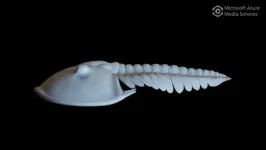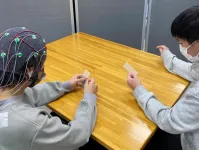(Press-News.org) Advisory Highlights:
Risk factors for cardiovascular disease are common among preteens and teens, and the need for preventive care to reduce their risk of cardiovascular disease exceeds the supply of health care resources, according to a new American Heart Association science advisory that reports survey results from pediatric cardiovascular health professionals.
Current data show that 39% of U.S. youth ages 12-19 meet criteria for obesity or overweight, 53% have high cholesterol, 18% with prediabetes and 15% have high blood pressure.
The advisory identifies the need for clinical practice guidelines, collaboration and best practices for staffing and training to ensure consistent, high-quality care for youth with risk factors for heart disease or stroke.
Embargoed until 4:00 a.m. CT / 5:00 a.m. ET, Monday, August 7, 2023
DALLAS, August 7, 2023 — More adolescents and teens are developing health conditions that may increase their risk of premature cardiovascular disease in adulthood, therefore, early screening, diagnosis and multidisciplinary care are vital. A new survey of cardiovascular care centers in the U.S. and Canada found that there are not enough resources to meet the needs for pediatric preventive cardiology care, and the survey results are detailed in a new American Heart Association science advisory, published today in the Association’s journal Circulation: Cardiovascular Quality & Outcomes.
The advisory is the first to address the status of pediatric preventive cardiology (PPC) programs in the U.S. and Canada and present a roadmap for the future of the field.
It reports that 39% of U.S. youth ages 12-19 are diagnosed as having overweight or obesity, 53% have abnormal lipids, 18% have prediabetes and 15% have elevated blood pressure. Children with these conditions have an increased risk of having a heart attack or stroke by the time they reach their 40s or 50s, according to previous research.
“Cardiovascular disease risk factors starting in childhood have important implications for health, quality of life, health care costs and societal costs across the whole life course,” said Amanda Marma Perak, M.D., M.S., FAHA, chair of the science advisory writing committee and an assistant professor of pediatrics (cardiology) and preventive medicine at Northwestern University’s Feinberg School of Medicine in Chicago.
PPC programs have been independently established across the United States and Canada to address cardiovascular disease risk factors before adulthood and prevent the development of cardiovascular disease. Unfortunately, many programs report being overwhelmed with referrals and have long wait times for appointments. Clinicians also report the need for updated guidelines for treating cardiovascular risk factors in youth to ensure consistent care.
To assess the current state of pediatric preventive cardiology, the advisory writing committee surveyed two groups of health professionals. One survey was for directors of pediatric cardiology divisions at university hospitals; the survey included questions about characteristics of the practice and personal opinions about PPC program needs and logistics. These hospital division programs were classified as small, medium and large based on the number of cardiac surgeries performed annually. The second survey was directed to lead clinicians at PPC programs across the United States and Canada, whether in a university setting or not. They were asked about current practices at the program, including the types of health professionals who are part of the team, therapies provided and future plans. The writing group received and analyzed responses from 53 division directors and 41 clinician leaders.
The survey of pediatric cardiology division directors revealed:
Dedicated PPC programs are established in 65% of large pediatric cardiology divisions, 61% of medium-sized divisions and 17% of small divisions.
The majority of respondents valued the programs, particularly to improve public health, manage patient volume and help generate research funding.
They largely agreed that PPC programs should provide care for children and teens with lipid disorders, high blood pressure, obesity or a family history of premature heart disease.
When asked about staffing, most directors responded that personnel for a PPC program should include a preventive cardiologist, registered dietician, nurse practitioner or physician’s assistant, and a registered dietitian.
About half endorsed that a psychologist or behavioral therapist be part of the PPC team, and 3 out of 4 suggested a social worker be included.
About one-third responded that a genetic counselor, vascular specialist, administrative assistant or research associate should also be on the PPC team.
The survey of PPC lead clinicians revealed:
Demand exceeds supply, with appointment wait-times of 3 months or longer in one-third of PPC programs.
While 37% of PPC clinicians were actively trying to build their programs, 34% reported being overwhelmed with referrals/new patient appointments.
Despite the need for more PPC specialists, training opportunities are limited, with only 2 of 41 programs offering fellowship training.
“These findings emphasize the challenges with resources, even when everyone believes certain practices may be beneficial,” said Perak, who is also an attending cardiologist at the Ann & Robert H. Lurie Children’s Hospital of Chicago.
The advisory suggests policymakers, payers, hospitals and heart centers should invest resources into PPC programs, including support for psychosocial and behavioral care.
Among predefined options to prioritize the most urgent needs, new practice guidelines were ranked as the highest or high priority by 4 out of 5 PPC clinicians. In their written responses, PPC clinicians seemed eager to collaborate on best practices and ways to reduce variations in practice among clinics.
The advisory calls on professional societies and foundations to advocate for PPC programs and to support PPC education, training and opportunities for networking and collaboration. The writing group calls for new research to fill gaps in the evidence about how to best prevent heart disease and stroke in children with risk factors, particularly those with high blood pressure and high cholesterol. They also identify the need to study novel ways to provide care and how to effectively implement lifestyle interventions in racially and economically diverse pediatric populations. The American Heart Association’s Young Hearts Council will be exploring opportunities to respond to and support these needs.
“Based on these findings, our hope is that health systems and policymakers will be motivated to reconsider how resources might be realigned to better support this priority area among high-risk youth, before cardiovascular disease develops,” said Perak.
According to the advisory, the key next steps include a comprehensive evidence review, updated guidelines and standards, and the development of a strategic action plan to advance PPC care.
American Heart Association science advisories assess potential new areas for cardiovascular care and may outline what is currently known about a topic, what areas need additional research and suggest improvements. While science advisories and scientific statements inform the development of guidelines, they do not make treatment recommendations. The advisory was prepared on behalf of the American Heart Association’s Council on Hypertension; the Council on Cardiovascular and Stroke Nursing; and the Council on Congenital Heart Disease and Heart Health in the Young (Young Hearts).
Writing committee members and disclosures are listed in the manuscript.
The Association receives funding primarily from individuals. Foundations and corporations (including pharmaceutical, device manufacturers and other companies) also make donations and fund specific Association programs and events. The Association has strict policies to prevent these relationships from influencing the science content. Revenues from pharmaceutical and biotech companies, device manufacturers and health insurance providers, and the Association’s overall financial information are available here.
Additional Resources:
Available multimedia is on the right column of the news release link. https://newsroom.heart.org/news/survey-of-cvd-programs-finds-more-resources-needed-for-heart-disease-and-stroke-risk-in-youth?preview=d799c25f545d11209bd12d53a04b3856
After August 7, view the manuscript online.
AHA Scientific Statement news release: Children with high blood pressure often become adults with high blood pressure (March 2023)
AHA Scientific Statement: Cardiovascular Risk Reduction in High-Risk Pediatric Patients: A Scientific Statement From the American Heart Association (Feb. 2019)
AHA news release: Only 1 in 5 people in the U.S. has optimal heart health (June 2022)
Follow AHA/ASA news on Twitter @HeartNews
About the American Heart Association
The American Heart Association is a relentless force for a world of longer, healthier lives. We are dedicated to ensuring equitable health in all communities. Through collaboration with numerous organizations, and powered by millions of volunteers, we fund innovative research, advocate for the public’s health and share lifesaving resources. The Dallas-based organization has been a leading source of health information for nearly a century. Connect with us on heart.org, Facebook, Twitter or by calling 1-800-AHA-USA1.
###
END
Survey of CVD programs finds more resources needed for heart disease and stroke risk in youth
A new American Heart Association science advisory urges clinical care guidelines for youth, and for hospitals, payers and policymakers to help meet the need for best practices in pediatric preventive cardiovascular care
2023-08-07
ELSE PRESS RELEASES FROM THIS DATE:
A wake-up call for kids’ poor heart health
2023-08-07
‘We’re not talking about primordial prevention. They’re already at risk for having an early heart attack or stroke’
First comprehensive study in 30 years to examine pediatric preventive cardiology in the U.S., Canada
Heart disease is the leading cause of death in U.S. adults
CHICAGO --- Today in the U.S., a child with risk factors for heart disease (high blood pressure, overweight, etc.) can wait close to a year to see a cardiologist because of high demand and limited resources. This is precious time that could be spent managing ...
The trilobites’ guide to surviving environmental change
2023-08-07
Scientists have worked out how one unusual species of trilobite — an ancient, sea-dwelling relative of spiders and lobsters — was able to defend itself against predators and survive a bumpy ride as Earth’s oxygen levels fluctuated.
The seas were filled with trilobites for nearly 300 million years starting in the Cambrian Period, some 520 million years ago. During their time on Earth, which lasted much longer than the dinosaurs, they survived two major episodes of mass extinctions and dominated ocean floor ecosystems.
Their ...
Sports media use linked to belief in rape myths
2023-08-07
PULLMAN, Wash. – Young men in a recent study who were regular consumers of sports media were more likely to accept rape myths, a set of false and prejudiced beliefs that can serve to excuse or downplay sexual assault.
This connection held even after accounting for participants who believed in certain negative “masculine norms,” namely that men should control women or they should be sexually permissive and try to have sex with as many women as possible.
“Sports media exposure had a unique contribution, and it was significant,” said Stacey Hust, a professor at Washington State University’s Murrow College of Communication and the study’s ...
Your presence matters: parallel group craft activities proven effective in occupational therapy
2023-08-07
Osaka, Japan – “Your presence means the world to me” may sound like a wedding invitation cliché, but an Osaka Metropolitan University study has shown that the presence of others while working does generate a state of relaxation and positive brain activity.
In psychiatry, occupational therapy encompasses not only the individual-therapist relationship but also occupational activities and group work. In clinical practice, having multiple individuals engage in separate activities within the same room has been deemed effective as part of occupational therapy. ...
Go with the flow
2023-08-06
The antibiotic cefazolin is an essential drug according to the World Health Organization (WHO). It is usually produced via batch manufacturing, but this multistep process is time-consuming, wasteful and requires very specialized facilities. Now for the first-time, researchers have manufactured cefazolin using the continuous-flow method. This method is cheaper, quicker, less wasteful and more flexible in terms of how much drug can be produced when it’s needed. Improving access to cefazolin is vital for global health and particularly relevant for countries such as Japan, which experienced a shortage in 2019. This study is published in the Bulletin ...
AI transformation of medicine: Why doctors are not prepared
2023-08-05
BALTIMORE, August 5, 2023–As artificial intelligence systems like ChatGPT find their way into everyday use, physicians will start to see these tools incorporated into their clinical practice to help them make important decisions on diagnosis and treatment of common medical conditions. These tools, called clinical decision support (CDS) algorithms, can be enormously helpful in helping guide health care providers in determining, for example, which antibiotics to prescribe or whether to recommend a risky heart surgery.
The success of these new technologies, however, depends largely on how physicians interpret and act upon a tool’s ...
We’re closer to engineering blood vessels
2023-08-05
University of Melbourne researchers have developed a fast, inexpensive and scalable method for engineering blood vessels from natural tissue.
Co-led by ARC Future Fellow Associate Professor Daniel Heath and Redmond Barry Distinguished Professor and Shanahan Chair in Frontier Medical Solutions Andrea O’Connor, both from the Department of Biomedical Engineering, the researchers employed a novel approach to ‘tissue engineering’ blood vessels.
By combining multiple materials and fabrication technologies, they developed a method to create blood vessels with complex geometries like native blood ...
Powerful gene editing approach boosts rotifers in pantheon of laboratory animals
2023-08-04
By Wynne Parry
Much about tiny, swimming rotifers makes them ideal study subjects. Although barely visible to the naked eye, these transparent animals and their innards are readily viewed under a microscope. What’s more, they grow readily in laboratory culture, offering scientists an otherwise difficult-to-obtain perspective from their corner of the animal kingdom.
However, while rotifers have been used experimentally for more than a century by many research groups, scientists have so far lacked the ability to readily manipulate rotifers’ genetics, placing a hard limit on the experiments they can run with these animals.
A joint ...
Elisabeth Huber-Sannwald named founding editor-in-chief of new ESA journal, Earth Stewardship
2023-08-04
The Ecological Society of America has named Elisabeth Huber-Sannwald, Ph.D., as the editor-in-chief of the newest title in its portfolio of journals. The international open-access journal, Earth Stewardship, will focus on facilitating collaborations between scientists and society to shape a sustainable future for nature and people. It will be ESA’s first publication focused on integrating the natural and social sciences; the humanities; and technical, local and Indigenous Knowledges.
Earth Stewardship will highlight perspectives from the southern ...
Confederated Tribes of the Umatilla Indian Reservation’s Department of Natural Resources Eric Quaempts selected as the 2023 ESA Regional Policy Award Winner
2023-08-04
The Ecological Society of America (ESA) will present its 16th annual Regional Policy Award to the Director for the Confederated Tribes of the Umatilla Indian Reservation’s (CTUIR) Department of Natural Resources Eric Quaempts on Sunday, Aug 6, 5:00pm EDT, during the ESA Conference Opening Plenary. The ESA annual award recognizes the use of ecological science to inform regional policy decisions. This is the first time in the history of the ESA policy award that a Tribal member and Tribal governance employee has been recognized for integrating tribal ecological approaches.
Since ...
LAST 30 PRESS RELEASES:
Potential new treatment for sepsis
Study reveals how many hours of video games per week might be too many
Electrospinning for mimicking bioelectric microenvironment in tissue regeneration
Home fingertip oxygen monitors less accurate for people with darker skin tones
Six weeks in a cast no less effective than surgery for unstable ankle fractures
Precautionary approach to alcohol-free and low alcohol drinks needed to protect public health, say experts
Gas-atomized Ca–Mg alloy powders produce hydrogen simply by adding water — high-efficiency hydrogen generation at room temperature
British redcoat’s lost memoir reveals harsh realities of life as a disabled veteran
World-leading rare earth magnet recycling facility launches in UK
Corday Selden selected for the Oceanography Society Early Career Award
MIT chemists determine the structure of the fuzzy coat that surrounds Tau proteins
Same moves, different terrain: How bacteria navigate complex environments without changing their playbook
Severe weather is deadly for vulnerable older adults long after the storm ends, study finds
Expert panel highlights opportunities for improving cancer studies
Hearing aid prescriptions not associated with changes in memory and thinking
Seth Zippel selected for The Oceanography Society Early Career Award
Jeremy Horowitz selected for The Oceanography Society Early Career Award
Kennesaw State University’s Jerry Mack named Paul “Bear” Bryant Newcomer Coach of the Year
Ancient teeth are treasure troves of data on Iron Age lifestyles
Avocados may become easier to grow in India—but not if global emissions remain high
Pregnant women with IBD show heightened inflammation in vaginal mucosa
Underwater photos show seabirds, seals and fish interacting with a tidal turbine in Washington State
1 in 5 surveyed UK adults who have experienced the death of a pet report it as more distressing than experienced human deaths, with significant rates of prolonged grief disorder symptoms also being re
Polyester microfibers in soil negatively impact the development of cherry tomato plants in experiments, raising concerns over the potential effect of high levels of such contaminants
LGBTQ+ adults may be around twice as likely to be unemployed or to report workforce non-participation compared to heterosexual adults, per large representative Australian survey
Horses can smell fear: In experiments where horses smelled sweat from scared humans, they reacted to scary and sudden events with increased fear and reduced human interaction
New synaptic formation in adolescence challenges conventional views of brain development
Scientists identify target to treat devastating brain disease
Oliver Zielinski selected as Fellow of The Oceanography Society
Has progress stalled on gender equality at work?
[Press-News.org] Survey of CVD programs finds more resources needed for heart disease and stroke risk in youthA new American Heart Association science advisory urges clinical care guidelines for youth, and for hospitals, payers and policymakers to help meet the need for best practices in pediatric preventive cardiovascular care




